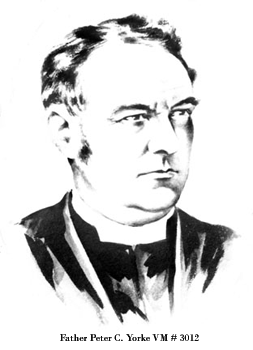|
||||
|
||||
|
|||||||||||||||||||
Two incidents marred the harmony of the meeting with General Greely yesterday morning, when President Roosevelt’s personal representative, Secretary of Commerce and Labor Victor H. Metcalf, was present. While H. Schussler, engineer for the Spring Valley [Water] Company was addressing the gathering, Father P.C. Yorke, pastor of St. Anthony’s Church, Oakland, interrupted the speaker.  “Wait a moment,” said Father Yorke. “I am here to find out if it is possible to get cots for 200 aged and infirm women without unraveling all the red tape in San Francisco.” He then explained that the inmates of St. Mary’s Hospital had been transferred to St. Anthony’s parish, and that he had been trying for several days to secure cots for them. “These old women,” he declared, “are sleeping on the floor. I have gone from one committee to another, and have been put off here with promises and there with more promises. I want 200 cots today and possibly 1,000 more tomorrow. Do you think I am going to steal your cots that you refuse to give them to me?” “Mr. Mayor,” said the priest, “you will be held personally responsible if with red tape you strangle American charity. If the present policy of administering assistance is continued, San Francisco twenty years hence will not be the greatest city of the Pacific Coast, but a fishing hamlet. I have nothing more to say.” He left the room before the Mayor could reply. John S. Drum was directed by Mayor Schmitz to furnish Father Yorke with the cots required. Scarcely had the excitement caused by this incident quieted, when Schussler continued his remarks concerning the water system. He was explaining the necessity for shutting off the water until the reservoirs could be filled, saying that it was necessary to have strong pressure in the mains to discover all the breaks and also to fill the reservoirs. “How long will it take to fill the reservoirs?” asked the Mayor. “I don’t know,” answered Schussler sharply. His manner more than words appeared to irritate the Mayor, who said: “Well, if you don’t know, it’s time for the city of San Francisco to own a water supply it can control, and a supply of which we can receive some definite knowledge.” “You are doing politics!” exclaimed Schussler. From all sides of the room came calls of “No, no.” “The water system is like a sieve with 10,000 holes,” declared Schussler. “Stop the waste and we will get our reservoirs filled.” Schussler wanted all house connections, with the exception of four to every city block, immediately discontinued. It was through the house connections that the great waste of water occurred that prevented the mains from filling. Congressman Julius Kahn arose and turned to Schussler. “When will you be able to get water into the reservoirs?” he asked. “How many days required?” “One day,” said Schussler. “Oh,” said the Mayor, “that is all we want to know, now we’ll give you three days for the purpose.” Thus the heated controversy was brought to a close, and Schussler insisted on shaking hands with the Mayor and assuring him that there was no [hard] feeling on his side. Engineer Schussler devoted considerable time to an explanation of water conditions before the row started. He explained that the pipes were badly strained in many places, and he was doing his best “to coax” water through them. The College Hill reservoir is being filled, and the pressure is being sent the length of Valencia street to Market. He expected to send the water down to Fifth street shortly.
“The great trouble,”
he said, “is the waste. The waste of water was not so great during
the first few days of the trouble, but in a large area of the city people
acting, I understand, under permission or direction from the health authorities,
are flushing their toilets with water. This order ought to be canceled.
At the present time 2,500,000 gallons of water are flowing through the
Eighteenth- Chairman Dillman of the water committee declared that house connections had been cut off in 400 blocks, and his committee was instructed to continue this work. It was also decided to ask the health authorities to countermand the order permitting people to flush their toilets with water.
Schussler wanted permission
to install a temporary pumping station in the city park at Twenty- |